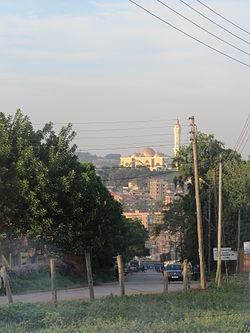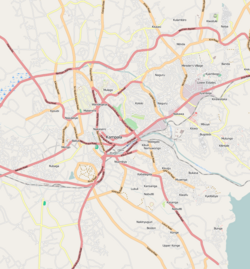Kampala Hill
| Kampala Hill | |
|---|---|

|
|
| Nickname(s): Old Kampala | |
| Map of Kampala showing the location of Kampala Hill. | |
| Coordinates: 00°18′55″N 32°34′07″E / 0.31528°N 32.56861°E | |
| Country |
|
| Region | Central Uganda |
| District | Kampala Capital City Authority |
| Division | Kampala Central Division |
| Elevation | 1,210 m (3,970 ft) |
| Time zone | EAT (UTC+3) |
Kampala Hill, commonly referred to as Old Kampala, is a hill in the center of Kampala, Uganda's capital and largest city.
Kampala Hill is bordered by Makerere to the north, Nakasero to the east, Mengo to the south and Namirembe to the west. When calculating distances between Kampala and other places, Kampala Hill is often taken as the starting point. The coordinates of the hill are:0°18'55.0"N, 32°34'07.0"E (Latitude: 0.315278; Longitude: 32.568611).
Kampala hill was the nucleus of the city of Kampala. When the city expanded to other neighboring hills, the place began to be referred to as Old Kampala, a name that is still in use today, 120 years later. As of June 2014[update], the hill is a mixed commercial and residential neighborhood with high-rise apartment complexes, shops, restaurants, bars, cafes, bed-and-breakfast establishments and several motels. The neighborhood is a beehive of activity, both during the week and on weekends.
Before the arrival of the British, Kampala Hill, along with the neighboring environs, was a favorite hunting ground of the King of Buganda. The area was particularly rich with game, especially Impala, a type of African antelope. The word Impala, most probably comes from the Zulu language. The British referred to the hill as the Hill of the Impala. The Luganda translation comes to Akasozi K'empala. Through repeated usage, the name of the place eventually became Kampala. The name then came to apply to the entire city.
Frederick Lugard, a British mercenary in the pay of Imperial British East Africa Company arrived in Uganda in the 1890s, built his fort on top of the hill. The original fort was relocated to a different site on the hill in 2003, to accommodate the largest mosque in Uganda, with a seating capacity of 15,000 people, built with monetary assistance from Libya. The completed mosque was opened officially in June 2007.
...
Wikipedia

